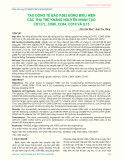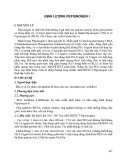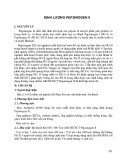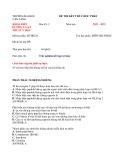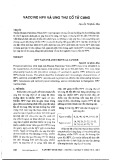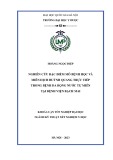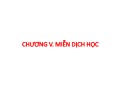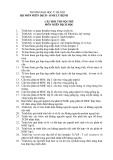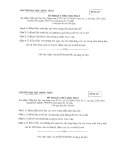SÖÏ HÌNH THAØNH MOÄT ÑAÙP ÖÙNG MIEÃN DÒCH
• GS Phaïm Hoaøng Phieät • BS Huyønh Thanh Bình
1
Ñoäng hoïc moät ñaùp öùng mieãn dòch
.
.
2
So saùnh ñaùp öùng thì 1 vaø thì 2
ÑÖMD
Thì 1
Thì 2
Tính chaát
Tieàm aån
1-2 tuaàn
3-5 ngaøy
Taêng SLKT Taêng nhanh
Taêng raát nhanh
Dieãn tieán
Bình oån
2-3 tuaàn
Nhieàu thaùng- naêm
Giaûm suùt
Nhanh
Töø töø
Cao hôn thì 1 nhieàu
Soá löôïng
Lôùp KT
IgM
IgG
Chaát löôïng
+
+++
3
Aùi löïc vôùi KN
Teá baøo trình dieän khaùng nguyeân
HLA lôùp II –TCD4 (peptid 15-34 aa)
HLA lôùp I –TCD8 (peptid 9 aa)
4
Class I MHC Pathway
Peptide is presented by MHC-I to CD8 cytotoxic T cell
Plasma membrane
Viral protein is made on cytoplasmic ribosomes
Globular viral protein - intact
rER
Peptide passes with MHC from Golgi body to surface
Peptide associates with MHC-I complex
Proteasome degrades protein to peptides
Peptide transporter protein moves peptide into ER
Golgi body
5
Peptide with MHC goes to Golgi body
MHC class I alpha and beta proteins are made on the rER
Class II MHC Pathway
CD4 helper T cell
Globular protein
Peptide MHC-II complex is presented to CD4 helper T cell
Endosome
Endocytosis
Endosome fuses with plasma membrane
Fusion of endosome and exocytic vesicle
Lysosome
Immunodominant peptide binds to class II MHC
Exocytic vesicle fuses with endosome releasing Ii from αβ dimer
Protein is processed to peptides in endosome or lysosome
Golgi body
α
Class II MHC Synthesis 3 chains: α,β and Ii
6
β Ii Endoplasmic reticulum
Hoaït hoùa Lympho T
ÑTB,Tc, (B)
4
IL2 (IL4)
3
2
1
7
Points Concerning Antigen Processing and Presentation 1. Location of pathogen • viruses in cytosol, MHC class I
pathway, Tc response
• extracellular bacteria, MHC class II
pathway, Th2 response, Ab formation
• intracellular bacteria, MHC class II
pathway, Th1 response
8
Points Concerning Antigen Processing and Presentation 2. Peptides derived from both self and non-self proteins can associate with MHC class I and class II molecules.
3. Chemical nature of MHC groove determines which peptides it will bind.
9
Hoaït hoùa Lympho baøo
T
B
sIg (BCR) KN
Tín hieäu KN
(1)Ti (TCR) KN (2) CD4 (TH) HLAII(APC)
IL2,IL4, IL5
(1) IFN- (TH) (2) IL1 (APC)
Tín hieäu thöù 2
10
Hoaït hoùa Lympho B
11
Söï hôïp taùc giöõa Ñaïi thöïc baøo, lympho T vaø lympho B
12
Cellular Events in 1o Response to T-dependent Ags
• Lag
– Clonal selection
1o Ag
IgM
• Log
– IgM – Class switching
IgG
Memory Cells
• Stationary • Decline • Memory Cell Pool
13
Cellular Events in 2o Response to T-dependent Ags
IgM
Virgin B cell
• Lag phase – Virgin cells – Memory cells
IgG
• Log phase – Pool size – IgG, IgA or IgE
Memory Cells
Memory Pool
IgG
• Stationary • Decline
– Sustained production
14 Memory Cells
Hieäu öùng Hapten-taûi
Hapten khoâng coù tính gaây MD Hapten phaûi gaén vôùi 1 protein taûi =>
phöùc hapten taûi (hapten-carrier complex)
Th nhaän dieän taûi, B nhaän dieän hapten Taûi ôû thì 1 vaø thì 2 phaûi gioáng nhau.
15
Söï hôïp taùc haïn cheá trong nhoùm phuø hôïp moâ (hieän töôïng Zinkernagel vaø Doherty)
Mouse Strain A or B Mouse Strain A or B
Immunize with antigen
Period of 7 days
Peritoneal macrophage
Antigen
T cells isolated from lymph nodes
Macrophage presents antigen
Anti X-induced
Macrophage T-cell proliferation
T cell primed with antigen
16
Macrophages and T cells are co-cultivated Assay DNA synthesis after 48 hr
Strain A Strain A Strain B Strain B A yes B no yes B no A
Tc Cell Self MHC Restriction
Mouse Strain A or B Mouse Strain A or B
Immunize with virus
Period of 7 days Purify Fibroblasts
Isolate spleen
Infect fibroblasts with virus and radiolabel with 51Cr
51Cr labeled fibroblast presents antigen
Virus-specific cytotoxic T cells (CTLs) isolated from spleen
Fibroblast 51Cr release
Spleen CTLs (target cells) from fibroblasts immunized infected (lysis) with with
Virus-specific CTLs
Assay 51Cr release
17
CTLs and fibroblasts are co-cultivated
Strain A Strain A Strain B Strain B A yes B no yes B no A
Self MHC Restriction in the Thymus
Sub-capsular region
4 low 8 low
4 - 8 low
Productive TCR rearrangement Non-productive TCR rearrangement
APOPTOSIS
Not recognise self MHC 4 + 8 + TCR
Recognise self MHC
macrophage
TCR recognises self antigens
Cortex
4 + 8 + TCR TCR does not recognise self antigens Negative selection
Cortico-medullary region
4 - 8 -
4 + 8 + TCR
Medulla
4 + 8 - TCR
18
vessel
4 - 8 + TCR
KN khoâng leä thuoäc thymus
Caáu truùc: ñaïi phaân töû do truøng phaân caùc ñôn
vò nhoû (lipopolysaccharide, dextran…)
Caùc epitop gioáng nhau treân ñaïi phaân töû lieân keát vôùi nhieàu sIg taïo thaønh ñaùm (hieän töôïng ñoäi muõ) => hoaït hoùa Lympho B thaønh töông baøo => SX KT
KT thuoäc lôùp IgM, khoâng taïo ra trí nhôù MD
19
Hieän töôïng ñoäi muõ
20







